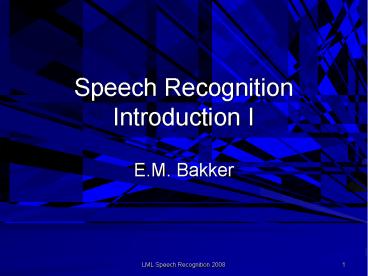Speech Recognition Introduction I - PowerPoint PPT Presentation
Title:
Speech Recognition Introduction I
Description:
Speech Recognition Introduction I E.M. Bakker Speech Recognition Some Applications An Overview General Architecture Speech Production Speech Perception Speech ... – PowerPoint PPT presentation
Number of Views:353
Avg rating:3.0/5.0
Title: Speech Recognition Introduction I
1
Speech RecognitionIntroduction I
- E.M. Bakker
2
Speech Recognition
- Some Applications
- An Overview
- General Architecture
- Speech Production
- Speech Perception
3
Speech Recognition
- Goal Automatically extract the string of words
spoken from the speech signal
4
Speech Recognition
- Goal Automatically extract the string of words
spoken from the speech signal
- How is SPEECH produced?
- Characteristics of
- Acoustic Signal
5
Speech Recognition
- Goal Automatically extract the string of words
spoken from the speech signal
How is SPEECH perceived? gt Important Features
6
Speech Recognition
- Goal Automatically extract the string of words
spoken from the speech signal
What LANGUAGE is spoken? gt Language Model
7
Speech Recognition
- Goal Automatically extract the string of words
spoken from the speech signal
What is in the BOX?
8
Important Componentsof General SR Architecture
- Speech Signals
- Signal Processing Functions
- Parameterization
- Acoustic Modeling (Learning Phase)
- Language Modeling (Learning Phase)
- Search Algorithms and Data Structures
- Evaluation
9
Recognition ArchitecturesA Communication
Theoretic Approach
Message Source
Linguistic Channel
Articulatory Channel
Acoustic Channel
Features
Observable Message
Words
Sounds
Speech Recognition Problem P(WA), where A
is acoustic signal, W words
spoken
Objective minimize the word error
rate Approach maximize P(WA) during training
- Bayesian formulation for speech recognition
- P(WA) P(AW) P(W) / P(A), A is
acoustic signal, W words spoken
- Components
- P(AW) acoustic model (hidden Markov models,
mixtures) - P(W) language model (statistical, finite
state networks, etc.) - The language model typically predicts a small set
of next words based on - knowledge of a finite number of previous words
(N-grams).
10
Recognition Architectures
Input Speech
Language Model P(W)
11
ASR Architecture
Evaluators
Feature Extraction
Recognition Searching Strategies
Speech Database, I/O
HMM Initialisation and Training
Common BaseClasses Configuration and Specification
Language Models
12
Signal ProcessingFunctionality
- Acoustic Transducers
- Sampling and Resampling
- Temporal Analysis
- Frequency Domain Analysis
- Ceps-tral Analysis
- Linear Prediction and LP-Based Representations
- Spectral Normalization
13
Acoustic Modeling Feature Extraction
Fourier Transform
Input Speech
Cepstral Analysis
Perceptual Weighting
Time Derivative
Time Derivative
Delta Energy Delta Cepstrum
Delta-Delta Energy Delta-Delta Cepstrum
Energy Mel-Spaced Cepstrum
14
Acoustic Modeling
- Dynamic Programming
- Markov Models
- Parameter Estimation
- HMM Training
- Continuous Mixtures
- Decision Trees
- Limitations and Practical Issues of HMM
15
Acoustic ModelingHidden Markov Models
- Acoustic models encode the temporal evolution of
the features (spectrum). - Gaussian mixture distributions are used to
account for variations in speaker, accent, and
pronunciation. - Phonetic model topologies are simple
left-to-right structures. - Skip states (time-warping) and multiple paths
(alternate pronunciations) are also common
features of models. - Sharing model parameters is a common strategy to
reduce complexity.
16
Acoustic Modeling Parameter Estimation
- Closed-loop data-driven modeling supervised from
a word-level transcription. - The expectation/maximization (EM) algorithm is
used to improve our parameter estimates. - Computationally efficient training algorithms
(Forward-Backward) have been crucial. - Batch mode parameter updates are typically
preferred. - Decision trees are used to optimize
parameter-sharing, system complexity, and the
use of additional linguistic knowledge.
17
Language Modeling
- Formal Language Theory
- Context-Free Grammars
- N-Gram Models and Complexity
- Smoothing
18
Language Modeling
19
Language Modeling N-Grams
20
LM Integration of Natural Language
21
Search Algorithms and Data Structures
- Basic Search Algorithms
- Time Synchronous Search
- Stack Decoding
- Lexical Trees
- Efficient Trees
22
Dynamic Programming-Based Search
23
Recognition Architectures
Input Speech
Language Model P(W)
24
Speech Recognition
- Goal Automatically extract the string of words
spoken from the speech signal
How is SPEECH produced?































